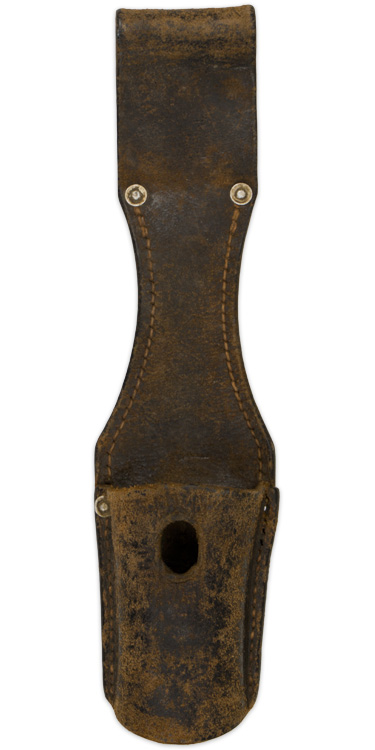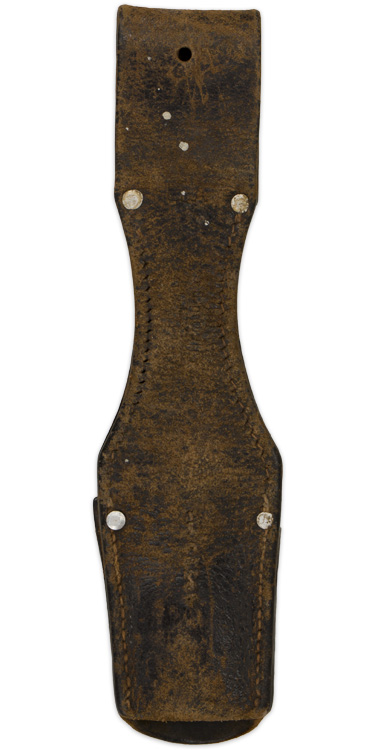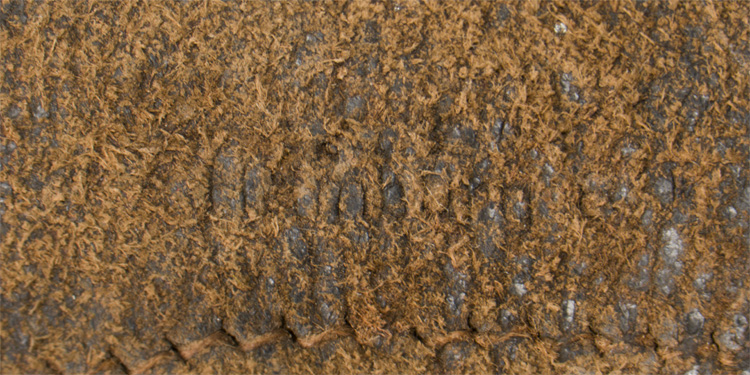





H112062 LUFTWAFFE K98 BAYONET FROG. (Seitengewehrtasche für K98)
BACKGROUND: Bayonets have a long history and their lineage and origins can be traced back to spears, pikes and halberds used in ancient times. The actual origins of the first bayonets has been obscured by time with different accounts attributing the bayonets birth to different people, locations and time periods. It can reasonable be established that the bayonet wasn’t introduced until after the advent of the use of gunpowder and muskets, for which they were designed to accompany. One account alleges the first bayonets originated prior to the 1650's, by chance rather then design, although other accounts trace the bayonet’s usage as far back as 1570 in both France and Germany. In his memoirs, posthumously released in 1747, French General, de Puységur the Elder, from Bayonne in southern France, (hence the term, bayonet), references use of bayonets during a battle at Ypres in 1647 when his musketeers had run out of powder and/or ball shot for their muskets and in desperation stuck their hunting knifes into the barrels of their muskets creating a spear/pike type weapon that would eventually evolve into the "modern" bayonet. The first real bayonets differed from their earlier ancestors in that they were specifically designed to be attached to the end of a firearm, creating a "two-in-one" type weapon. The earliest bayonets were the "plug" type with the handle of the bayonet being secured into the musket barrel effectively neutralizing the use of the musket. The early, relatively impractical "plug" type bayonets evolved into the "socket" type which allowed the firearm to be used with the bayonet secured in place. Eventually an assortment of bayonet/firearm attachments were developed by different nations and with the unification of the assorted German states in 1871 the "TO" slotted, press stud, style of bayonet/firearm attachment was adopted as the standard form of bayonet/rifle attachment and remained in use, with some refinements, through-out both World wars and beyond. The Prussian/German S84/98 bayonet was first introduced by the Imperial German army circa 1905 and was a modification of the earlier S71/84 bayonet which had been adopted in January 1884. In 1915 a new pattern S84/98 bayonet was produced which had minor modifications. The modified S84/98 bayonets were manufactured until 1917 when further minor modifications were enacted in 1918. The S84/98 bayonet continued in production during the Weimar Reichswehr, era, (National Defence Force, Circa 1919-1933). Although another modification of the S84/98 bayonet, designated as the K98 bayonet, began production in 1934, the earlier pattern S84/98 bayonets continued to be manufactured, in limited quantities, right up until late in WWII. Although production of the new K98 bayonet had begun in 1934 it wasn’t until 1936 that mass production began. The K98 bayonet was a standard issue item and was accompanied by a bayonet frog to be worn on the reverse, left side, of the load-bearing waist belt. The K98 bayonet remained the standard issue bayonet through-out the war with minor manufacturing variations. As the war continued the quality of the bayonets deteriorated and in mid-1944 most manufacturers discontinued producing the bayonet to concentrate on producing other essential war materials. Originally the German army utilized two patterns of bayonet frogs with one pattern for unmounted personnel and another pattern with the addition of a horizontal retaining strap for mounted personnel. Regulations of January 25TH 1939 dictated that the bayonet frog without the retaining strap was to be discontinued and replaced by the bayonet frog with the horizontal retaining strap for all personnel although the changeover was never completely achieved. In 1942, due to leather shortages, another simplified or "skeletonized" version of the bayonet frog was introduced which were easier to produce and utilized less leather. Allegedly these simplified frogs were originally introduced by the Waffen-SS, (Armed-SS), although eventually they were issued to all branches of service.
PHYSICAL DESCRIPTION: Early pattern, blackened leather construction K98 bayonet frog for issue to all unmounted personnel. The frog consists of a roughly, 24cm tall, 57mm wide at its widest point and 34mm, wide at its narrowest point, dual layered, hour glass shaped leather panels with a belt loop to the top edge and a stitched on bayonet pocket to the bottom edge of the obverse. The base of the frog has a row of stitching near each outside edge with aluminum reinforcement rivets positioned on either side at the bottom edge of the belt loop and an additional rivet to each side of the reverse top edge of the bayonet pocket. The frog also an additional, short, row of stitching running vertically down the center of both the obverse and reverse panels. The bayonet pocket is stitched down sides with a central vertically oval front lug hole. The reverse of the frog has a faint makers mark, but too hard to read. Frog is LBA (Luftwaffe) marked. The frog is in a very worn and used condition and one of the side pocket rivets has pulled loose. Would work well with a similar condition bayonet. Nice salty example.
GRADE ***3/4 PRICE $69.00
To Order this item, please use one of the two e-mail addresses below to contact us. Please make sure to quote the item number in your e-mail
MILITARIA WANTED! If you have items for sale, please contact us. We specialize in selling single pieces and entire collections. Over 3 decades in the business and we do all the work for you. Get the best return for your investment.
-E-Mail Address pawmac@nbnet.nb.ca Or guild@nb.aibn.com
To return to the main page please CLICK below